A Spatially Informed Machine Learning Method for Predicting Sound Field Uncertainty
Abstract
1. Introduction
2. Problem Setting
3. Machine Learning Model
3.1. Specifics of the Model Input: The Position of the Receiver and Environmental Information
3.2. The Particular Structure of the Model
3.3. Loss Function
4. Dateset Construction and Division
4.1. The Process of Dataset Construction
4.2. Division of Training and Testing Datasets
5. Experiments
5.1. Implementation
| Algorithm 1 Training SICNet via Forward and Backward Propagation |
|
5.2. Experimental Results
5.2.1. Performance Analysis
5.2.2. Performance Comparison
6. Conclusions
Author Contributions
Funding
Institutional Review Board Statement
Informed Consent Statement
Data Availability Statement
Acknowledgments
Conflicts of Interest
Abbreviations
| TL | Transmission Loss |
| Probability Density Function | |
| SICNet | Spatially Informed Convolutional Neural Network |
| MLP | Multi-Layer Perceptron |
| ResNet-18 | Residual Network with 18 layers |
| TV distance | Total Variation distance |
| KS | Kolmogorov–Smirnov |
References
- Song, A.; Badiey, M.; Song, H.C.; Hodgkiss, W.S.; Porter, M.B. Impact of ocean variability on coherent underwater acoustic communications during the Kauai experiment (KauaiEx). J. Acoust. Soc. Am. 2008, 123, 856–865. [Google Scholar] [CrossRef] [PubMed]
- Sha, L.; Nolte, L.W. Effects of environmental uncertainties on sonar detection performance prediction. J. Acoust. Soc. Am. 2005, 117, 1942–1953. [Google Scholar] [CrossRef]
- Masetti, G.; Kelley, J.G.W.; Johnson, P.; Beaudoin, J. A ray-tracing uncertainty estimation tool for ocean mapping. IEEE Access 2017, 6, 2136–2144. [Google Scholar] [CrossRef]
- Kessel, R.T. A mode-based measure of field sensitivity to geoacoustic parameters in weakly range-dependent environments. J. Acoust. Soc. Am. 1999, 105, 122–129. [Google Scholar] [CrossRef]
- Metropolis, N. The beginning. Los Alamos Sci. 1987, 15, 125–130. [Google Scholar]
- Finette, S. A stochastic representation of environmental uncertainty and its coupling to acoustic wave propagation in ocean waveguides. J. Acoust. Soc. Am. 2006, 120, 2567–2579. [Google Scholar] [CrossRef]
- Hou, T.Y.; Luo, W.; Rozovskii, B.; Zhou, H.M. Wiener chaos expansions and numerical solutions of randomly forced equations of fluid mechanics. J. Comput. Phys. 2006, 216, 687–706. [Google Scholar] [CrossRef]
- Dosso, S.E.; Morley, M.G.; Giles, P.M.; Brooke, G.H.; McCammon, D.F.; Pecknold, S.; Hines, P.C. Spatial field shifts in ocean acoustic environmental sensitivity analysis. J. Acoust. Soc. Am. 2007, 122, 2560–2570. [Google Scholar] [CrossRef]
- James, K.R.; Dowling, D.R. A method for approximating acoustic-field-amplitude uncertainty caused by environmental uncertainties. J. Acoust. Soc. Am. 2008, 124, 1465–1476. [Google Scholar] [CrossRef]
- Roberts, P.L.; Jaffe, J.S.; Trivedi, M.M. Multiview, broadband acoustic classification of marine fish: A machine learning framework and comparative analysis. IEEE J. Ocean. Eng. 2011, 36, 90–104. [Google Scholar] [CrossRef]
- Lowell, K.; Hermann, J. Accuracy of bathymetric depth change maps using multi-temporal images and machine learning. J. Mar. Sci. Eng. 2024, 12, 1401. [Google Scholar] [CrossRef]
- O’Byrne, M.; Pakrashi, V.; Schoefs, F.; Ghosh, B. Semantic segmentation of underwater imagery using deep networks trained on synthetic imagery. J. Mar. Sci. Eng. 2018, 6, 93. [Google Scholar] [CrossRef]
- Niu, H.; Ozanich, E.; Gerstoft, P. Ship localization in Santa Barbara Channel using machine learning classifiers. J. Acoust. Soc. Am. 2017, 142, EL455–EL460. [Google Scholar] [CrossRef] [PubMed]
- Seo, D.; Lee, D.; Park, S.; Oh, S. Hyperspectral Image-Based Identification of Maritime Objects Using Convolutional Neural Networks and Classifier Models. J. Mar. Sci. Eng. 2024, 13, 6. [Google Scholar] [CrossRef]
- Shi, J.H.; Liu, Z.j. Deep learning in unmanned surface vehicles collision-avoidance pattern based on AIS big data with double GRU-RNN. J. Mar. Sci. Eng. 2020, 8, 682. [Google Scholar] [CrossRef]
- Niu, H.; Reeves, E.; Gerstoft, P. Source localization in an ocean waveguide using supervised machine learning. J. Acoust. Soc. Am. 2017, 142, 1176–1188. [Google Scholar] [CrossRef]
- Wang, D.; Zhang, Y.; Wu, L.; Tai, Y.; Wang, H.; Wang, J.; Meriaudeau, F.; Yang, F. Robust Underwater Acoustic Channel Estimation Method Based on Bias-Free Convolutional Neural Network. J. Mar. Sci. Eng. 2024, 12, 134. [Google Scholar] [CrossRef]
- Zhang, Y.; Wang, H.; Li, C.; Chen, D.; Meriaudeau, F. Meta-learning-aided orthogonal frequency division multiplexing for underwater acoustic communications. J. Acoust. Soc. Am. 2021, 149, 4596–4606. [Google Scholar] [CrossRef]
- Lee, B.M.; Johnson, J.R.; Dowling, D.R. Predicting Acoustic Transmission Loss Uncertainty in Ocean Environments with Neural Networks. J. Mar. Sci. Eng. 2022, 10, 1548. [Google Scholar] [CrossRef]
- Hu, J.; Shen, L.; Sun, G. Squeeze-and-excitation networks. In Proceedings of the IEEE Conference on Computer Vision and Pattern Recognition, Salt Lake City, UT, USA, 18–22 June 2018; pp. 7132–7141. [Google Scholar]
- Karpathy, A.; Toderici, G.; Shetty, S.; Leung, T.; Sukthankar, R.; Fei-Fei, L. Large-scale video classification with convolutional neural networks. In Proceedings of the IEEE Conference on Computer Vision and Pattern Recognition, Columbus, OH, USA, 23–28 June 2014; pp. 1725–1732. [Google Scholar]
- Krizhevsky, A.; Sutskever, I.; Hinton, G.E. Imagenet classification with deep convolutional neural networks. Adv. Neural Inf. Process. Syst. 2012, 25. [Google Scholar] [CrossRef]
- Gardner, M.W.; Dorling, S. Artificial neural networks (the multilayer perceptron)—A review of applications in the atmospheric sciences. Atmos. Environ. 1998, 32, 2627–2636. [Google Scholar] [CrossRef]
- Chassignet, E.P.; Hurlburt, H.E.; Smedstad, O.M.; Halliwell, G.R.; Hogan, P.J.; Wallcraft, A.J.; Baraille, R.; Bleck, R. The HYCOM (Hybrid Coordinate Ocean Model) Data Assimilative System. J. Mar. Syst. 2007, 65, 60–83. [Google Scholar] [CrossRef]
- Collins, M.D. A split-step Padé solution for the parabolic equation method. J. Acoust. Soc. Am. 1993, 93, 1736–1742. [Google Scholar] [CrossRef]
- Robinson, A.; Abbot, P.; Lermusiaux, P.; Dillman, L. Transfer of uncertainties through physical-acoustical-sonar end-to-end systems: A conceptual basis. In Impact of Littoral Environmental Variability of Acoustic Predictions and Sonar Performance; Springer: Berlin/Heidelberg, Germany, 2002; pp. 603–610. [Google Scholar]
- Baggeroer, A.B.; Kuperman, W.A.; Mikhalevsky, P.N. An overview of matched field methods in ocean acoustics. IEEE J. Ocean. Eng. 1993, 18, 401–424. [Google Scholar] [CrossRef]
- Sanjay, N.S.; Ahmadinia, A. MobileNet-Tiny: A deep neural network-based real-time object detection for rasberry Pi. In Proceedings of the 2019 18th IEEE International Conference On Machine Learning And Applications (ICMLA), Boca Raton, FL, USA, 16–19 December 2019; pp. 647–652. [Google Scholar]
- Lin, M.; Chen, Q.; Yan, S. Network in network. arXiv 2013, arXiv:1312.4400. [Google Scholar]
- Levin, D.A.; Peres, Y. Markov Chains and Mixing Times; American Mathematical Soc.: Washington, DA, USA, 2017; Volume 107. [Google Scholar]
- Del Grosso, V.A. New equation for the speed of sound in natural waters (with comparisons to other equations). J. Acoust. Soc. Am. 1974, 56, 1084–1091. [Google Scholar] [CrossRef]
- Ws, H.C.P. Validation of statistical estimation of transmission loss in the presence of geoacoustic inversion uncertainty. J. Acoust. Soc. Am. 2006, 120, 1932–1941. [Google Scholar]
- Tozer, B.; Sandwell, D.T.; Smith, W.H.F.; Olson, C.; Beale, J.R.; Wessel, P. Global Bathymetry and Topography at 15 Arc Sec: SRTM15+. Earth Space Sci. 2019, 6, 1847–1864. [Google Scholar] [CrossRef]
- Huang, C.F.; Gerstoft, P.; Hodgkiss, W.S. Uncertainty analysis in matched-field geoacoustic inversions. J. Acoust. Soc. Am. 2006, 119, 197–207. [Google Scholar] [CrossRef]
- Run, L.; Chunmei, Y.; Peng, S.; Guanbao, L.; Zongwei, L.; Ying, J.; Liangang, L. Sensitivity Analysis of Geo-Acoustic Parameters in the South China Sea Based on Acoustic Transmission Loss. Adv. Mar. Sci. 2024, 42, 590–601. [Google Scholar]
- Massey Jr, F.J. The Kolmogorov–Smirnov test for goodness of fit. J. Am. Stat. Assoc. 1951, 46, 68–78. [Google Scholar] [CrossRef]
- Rice, J.A. Mathematical Statistics and Data Analysis; Cengage Learning; Thomson/Brooks/Cole: Belmont, CA, USA, 2006. [Google Scholar]
- He, K.; Zhang, X.; Ren, S.; Sun, J. Deep residual learning for image recognition. In Proceedings of the IEEE Conference on Computer Vision and Pattern Recognition, Las Vegas, NV, USA, 26 June–1 July 2016; pp. 770–778. [Google Scholar]

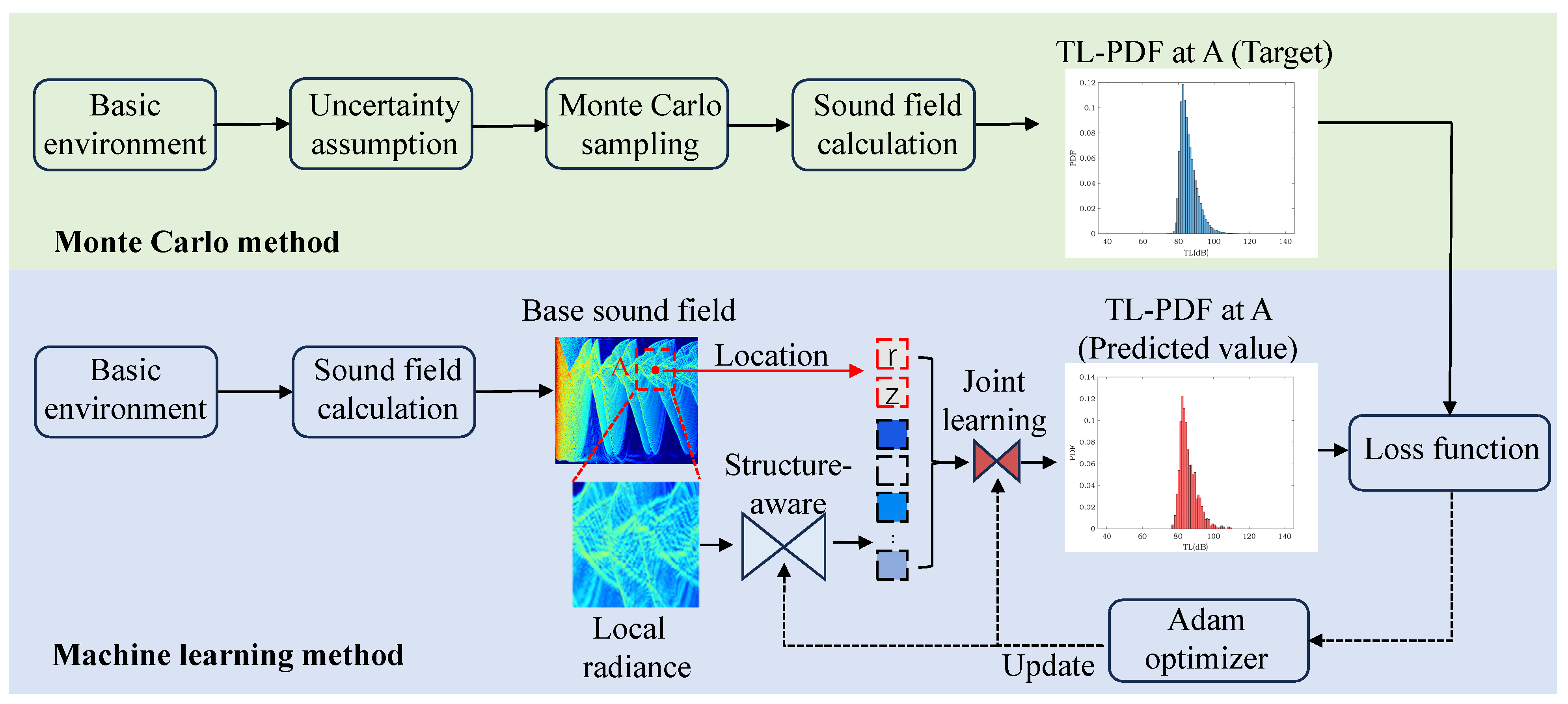
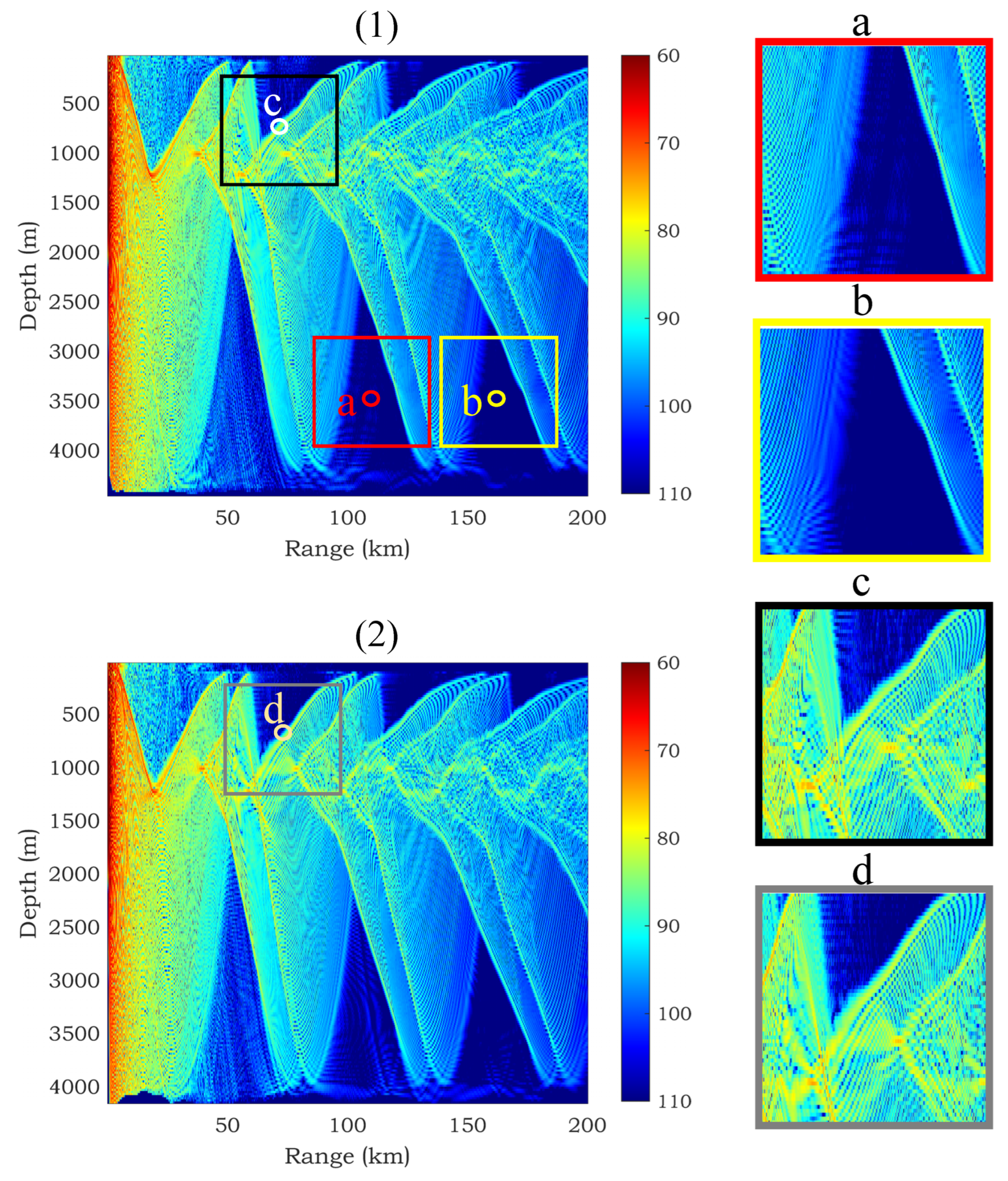
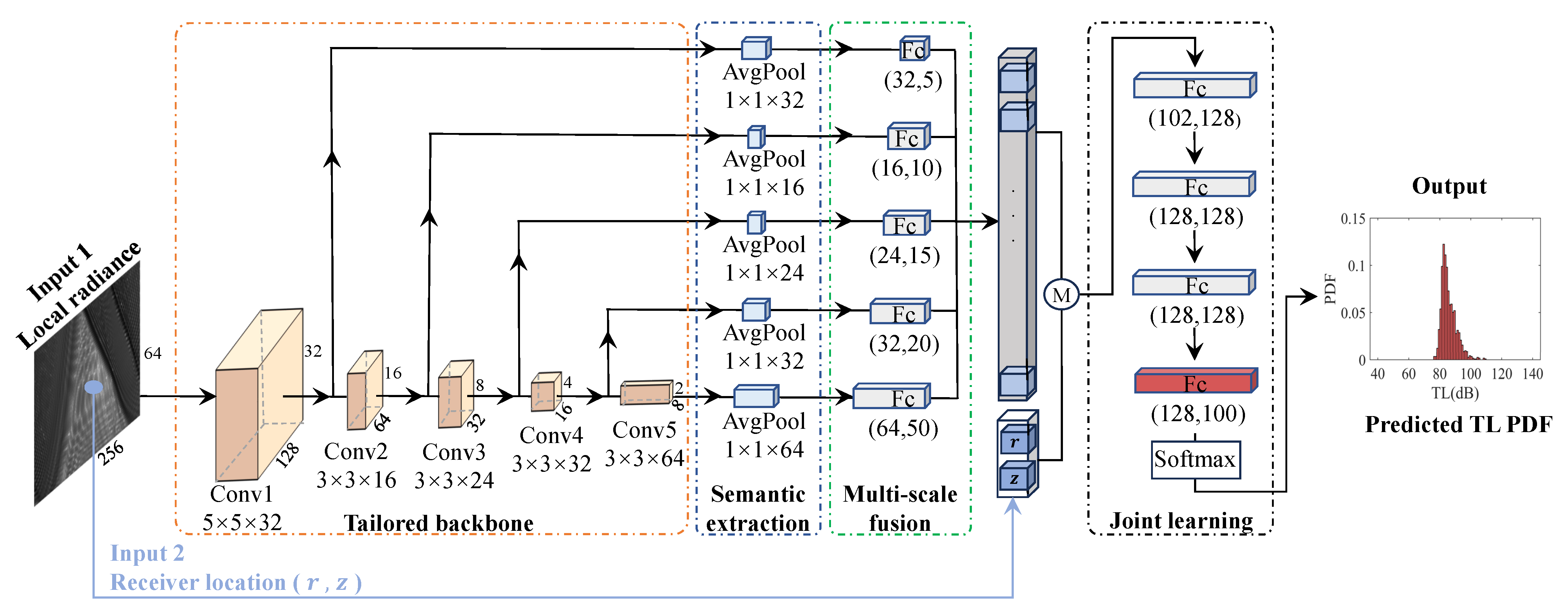
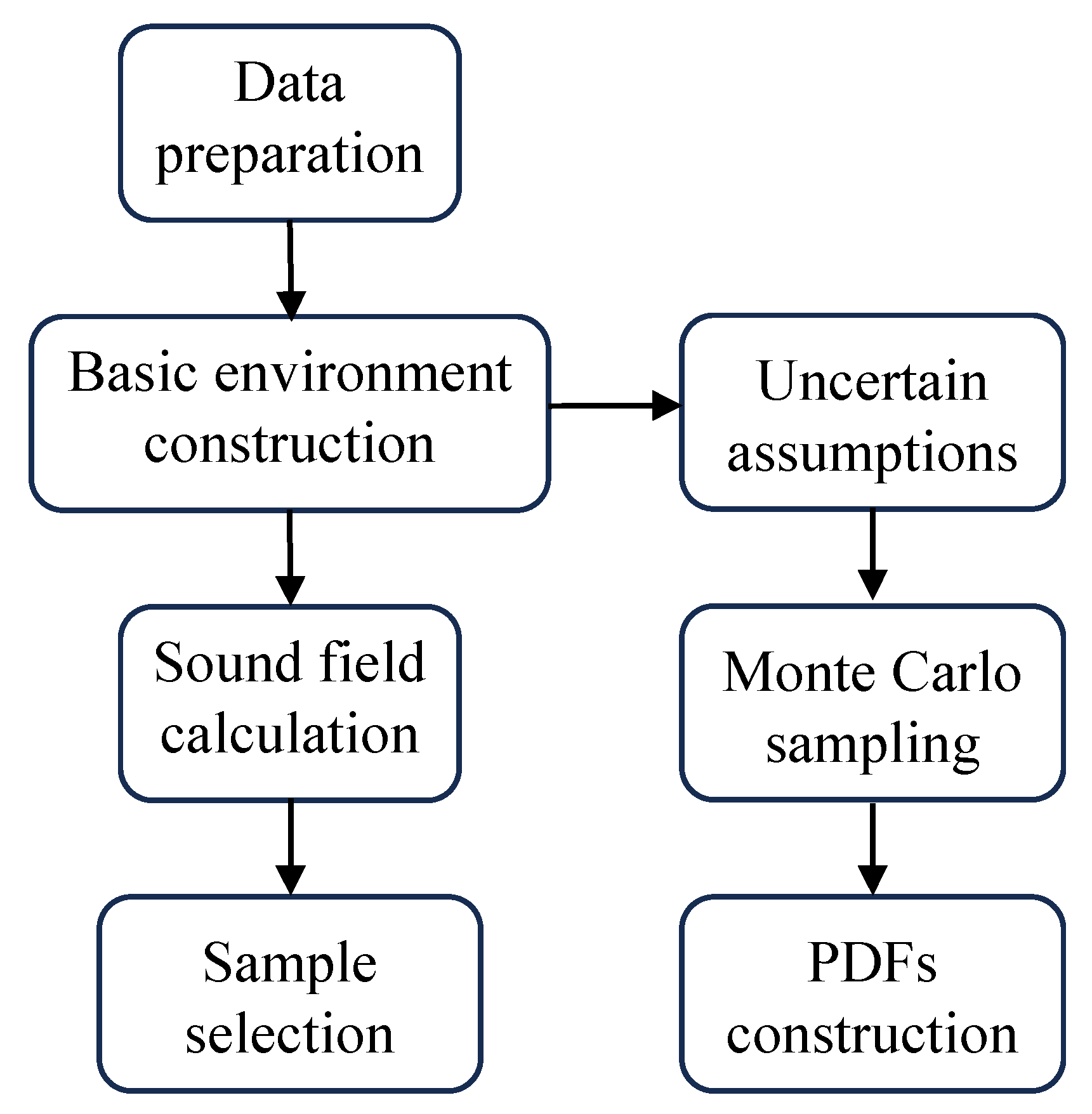

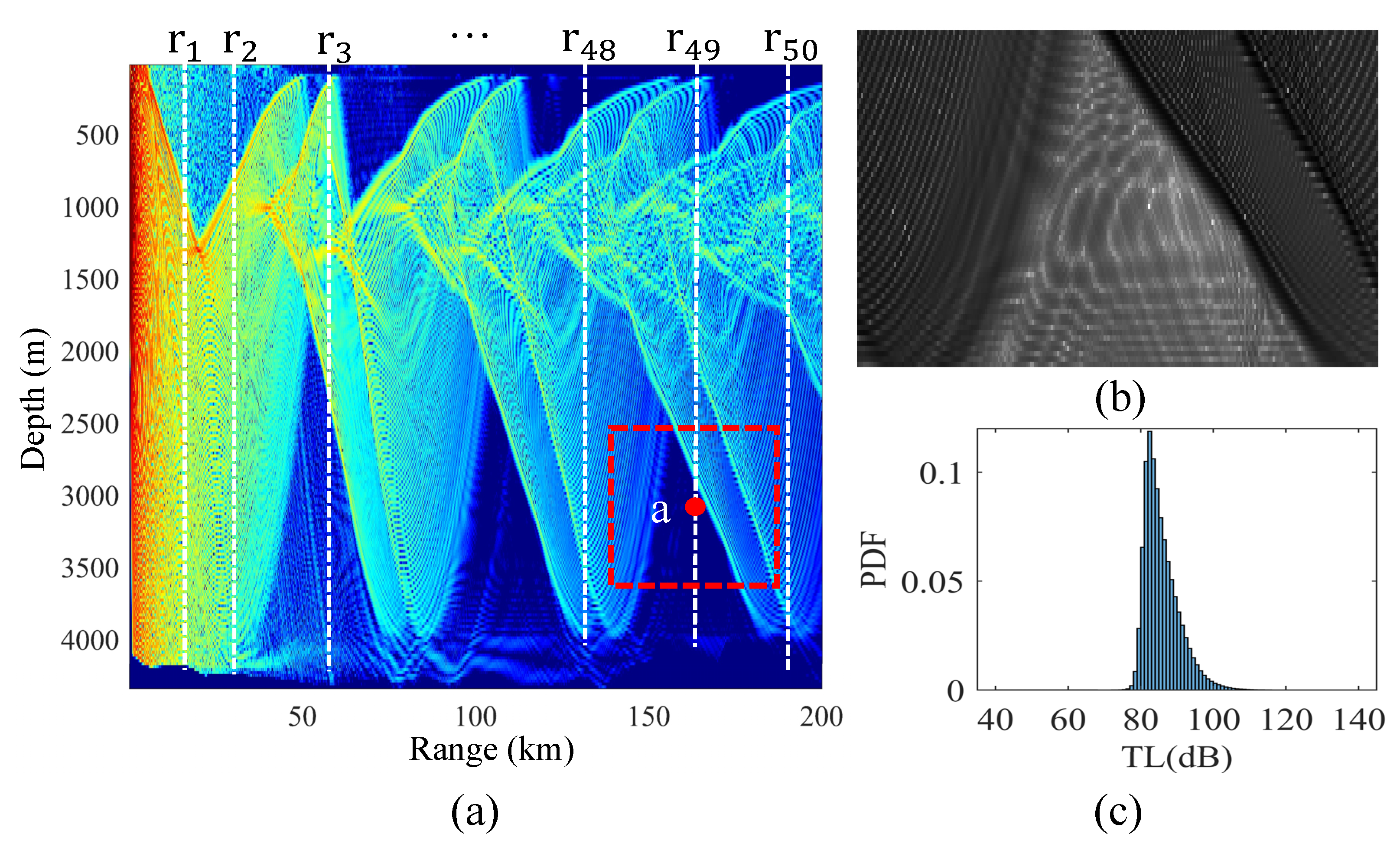






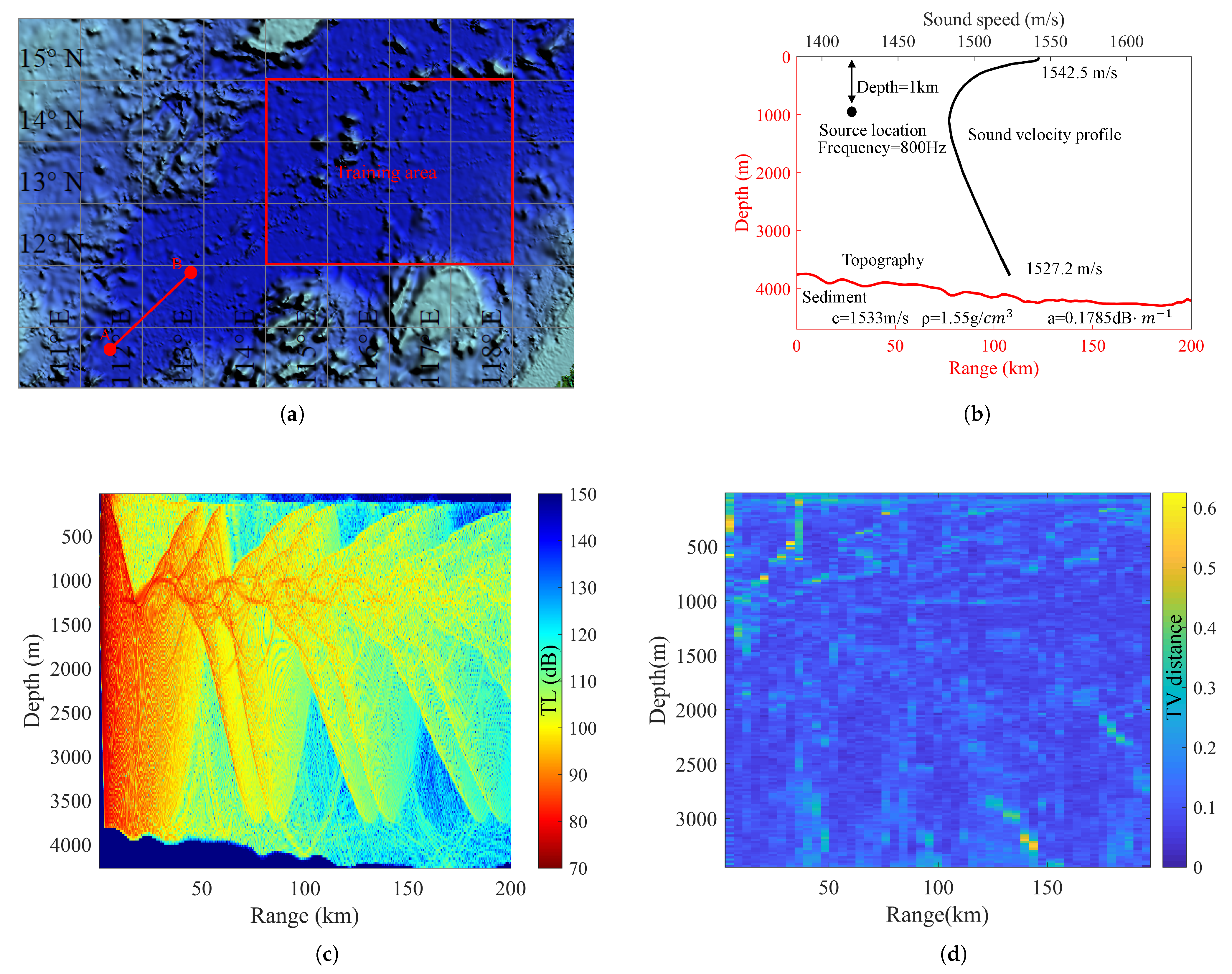

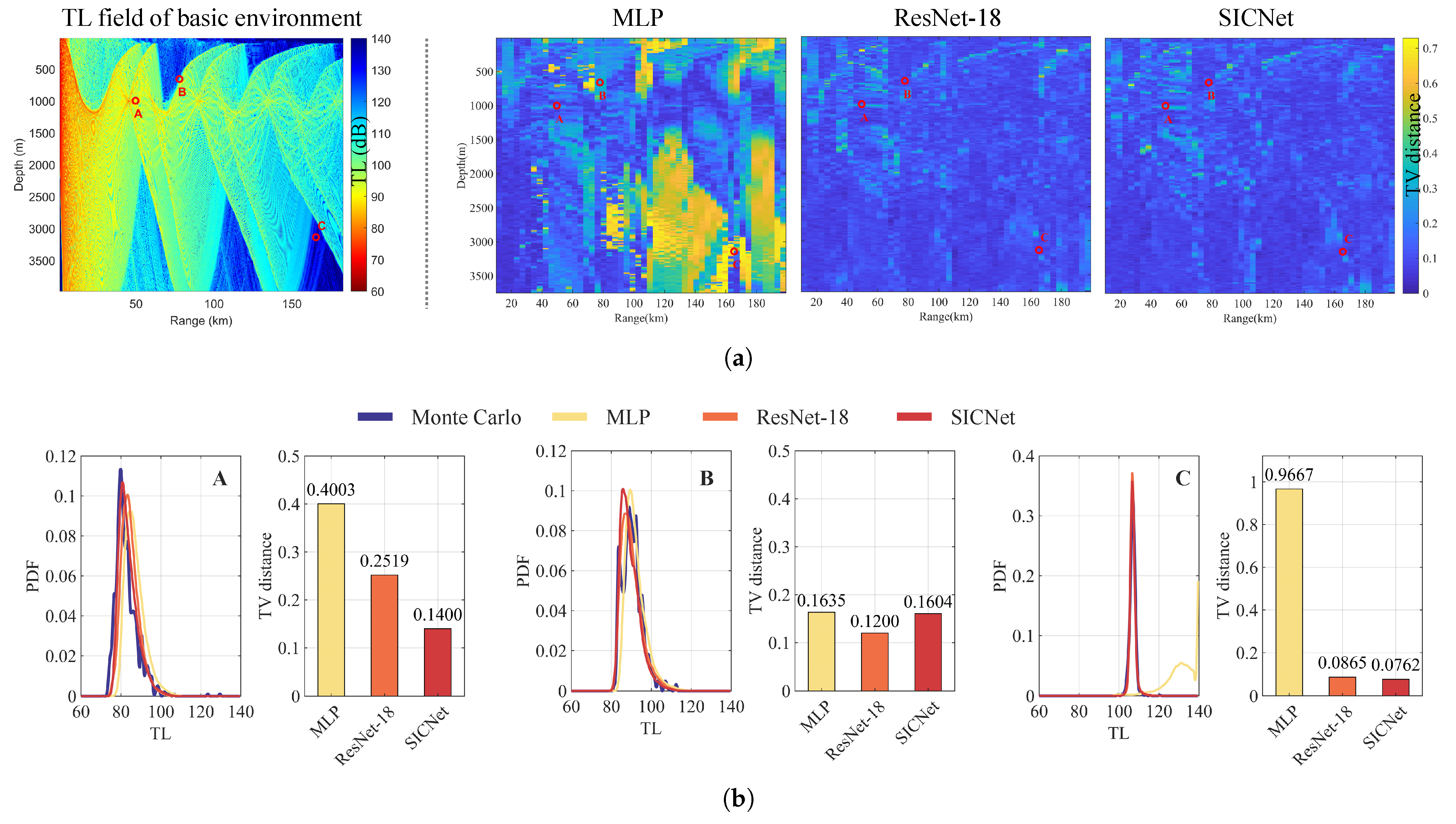
| Parameter | Description | Optimal Value |
|---|---|---|
| Optimizer | Adam | - |
| Learning Rate | - | |
| Batch Size | - | 256 |
| Epoch Number | - | 200 |
| Method | KS Test | TV Distance | Parameter Numbers | Model Size |
|---|---|---|---|---|
| MLP | 73.59% | 0.3263 | 108,516 | 1106 KB |
| ResNet-18 | 97.84% | 0.1147 | 2,931,184 | 44,427 KB |
| SICNet | 97.58% | 0.1166 | 69,784 | 678 KB |
Disclaimer/Publisher’s Note: The statements, opinions and data contained in all publications are solely those of the individual author(s) and contributor(s) and not of MDPI and/or the editor(s). MDPI and/or the editor(s) disclaim responsibility for any injury to people or property resulting from any ideas, methods, instructions or products referred to in the content. |
© 2025 by the authors. Licensee MDPI, Basel, Switzerland. This article is an open access article distributed under the terms and conditions of the Creative Commons Attribution (CC BY) license (https://creativecommons.org/licenses/by/4.0/).
Share and Cite
Chen, X.; Li, C.; Wang, H.; Tai, Y.; Wang, J.; Migniot, C. A Spatially Informed Machine Learning Method for Predicting Sound Field Uncertainty. J. Mar. Sci. Eng. 2025, 13, 429. https://doi.org/10.3390/jmse13030429
Chen X, Li C, Wang H, Tai Y, Wang J, Migniot C. A Spatially Informed Machine Learning Method for Predicting Sound Field Uncertainty. Journal of Marine Science and Engineering. 2025; 13(3):429. https://doi.org/10.3390/jmse13030429
Chicago/Turabian StyleChen, Xiangmei, Chao Li, Haibin Wang, Yupeng Tai, Jun Wang, and Cyrille Migniot. 2025. "A Spatially Informed Machine Learning Method for Predicting Sound Field Uncertainty" Journal of Marine Science and Engineering 13, no. 3: 429. https://doi.org/10.3390/jmse13030429
APA StyleChen, X., Li, C., Wang, H., Tai, Y., Wang, J., & Migniot, C. (2025). A Spatially Informed Machine Learning Method for Predicting Sound Field Uncertainty. Journal of Marine Science and Engineering, 13(3), 429. https://doi.org/10.3390/jmse13030429








